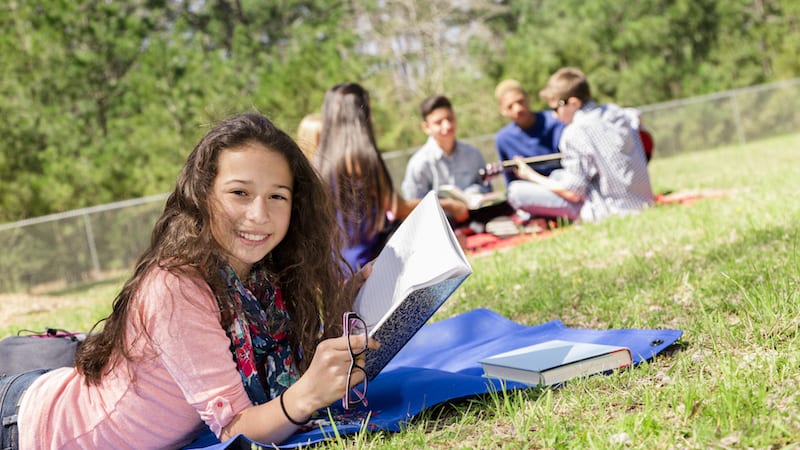Some of the standards for middle schoolers are great, like finding textual evidence to support an analysis. Others, like knowing the difference between reflexive and intensive pronouns, not so much. Some of my most important goals for my students lie completely outside the standards, but I think they’re essential to my kids’ success. These six social and study skills for middle school students will stay with them long after they leave the classroom.
1. How to monotask.
Is monotask even a word? Unitask? Whatever terminology you prefer, I want my kids to know how to do one thing at a time, and it’s not a skill they’ll pick up on their own. Let’s say I ask them to write a story for homework. They’re not going to sit down, come up with an idea, and get lost in the flow of creating a narrative. The vast majority of them will be constantly interrupted by some device beeping, dinging. or otherwise reminding them of their need to be continually connected to everyone they know.
Sustained concentration is a gift, and it’s generally lacking from my students’ lives. I try to build in time for them to work on things in class because, for most of them, it’s the only time they work interruption-free, which is essential to developing their creativity.
2. How they study best.
We tell kids to study all the time, but mine have no idea how to do so. And they don’t realize that the process may look different for different people. Some people have to write things down to remember them. Others need to say them out loud. Personally, I remember things best if I walk around the room while I’m studying. But for my kids, “study” means “look at your notes for a predetermined period of time.” No focus necessary.
When I need kids to study, we talk about ways to retain information, and kids come up with a plan for how they’ll spend their study time. After they take an assessment, I ask them to reflect on the effectiveness of their study strategies.
3. How to use metacognition.
This goes with the previous learning goal. As an adult, I can read a paragraph, realize that I wasn’t paying attention or didn’t understand it, and then go back and read it again. My kids don’t do that. They don’t read for understanding; they read because someone told them to. If they have decoded all the words in a given text—whether those words make any sense or not—they’re done.
I want them to learn how to check their understanding as they read and figure out the parts they don’t get the first time. I try to model this in class, especially when we’re reading nonfiction.
4. How to prioritize.
Whenever I have a job I don’t want to do, I procrastinate by cleaning my house. That way I’m still doing something productive, so I don’t feel bad about not tackling whatever I should’ve been working on. My kids do the exact same thing with projects. If I tell them to do a research presentation, they’re going to have 17 really intricate slide transitions before they do a single bit of research. If I ask them to write a skit using their vocabulary words, they’ll spend a whole period making fake boobs for a kid’s costume and never actually come up with a script. Ask them, and they think they’ve spent their time productively working on their project.
I want them to learn how to focus on the difficult parts of a project first, then move on to the fun stuff. At the beginning of the year, I give them a list of steps that have to be completed in order for projects. By this point, I ask them to spend a few minutes at the beginning of the activity prioritizing what needs to get done first and how they’re going to accomplish it.
5. How to play to their strengths.
I blame the school system for this one. We’re very into a standardized process and a standardized product for every kid, which becomes less and less reasonable as the kids get older. My fifth period is doing book circles now, and they have a set number of pages to read every week and a group assignment to show me their comprehension. I met with a group a few days ago and found them reading out loud “popcorn” style, despite the fact that some members of the group are much more fluent readers than the others. They’d taken turns writing answers to the questions, too, so that some were totally illegible and others were works of art.
“Let your good readers read,” I told them. “Let your neat writers write, let your good artists draw the cartoon for your project, and let the leaders decide what pages you’re reading for homework tonight. It’s okay if not everybody does the exact same things.”
6. How to read—and maybe even write—for pleasure.
Teaching this is my favorite part of my job. Lucky for me, it’s also the most important. Kids who read independently for pleasure go on to have greater success academically, professionally, and personally according to several well-documented studies. Modeling a love of reading, making room for passion in writing, and pointing kids toward the right books are all hugely important components of teaching middle school that are ignored by the standards.
There are skills I want my kids to have, of course, and there are always the ever-present standards. But if my seventh graders leave me a little better at these six things than they were at the beginning of the year, I’ll feel that I’ve done something to prepare them for the future, no matter what that future holds.

